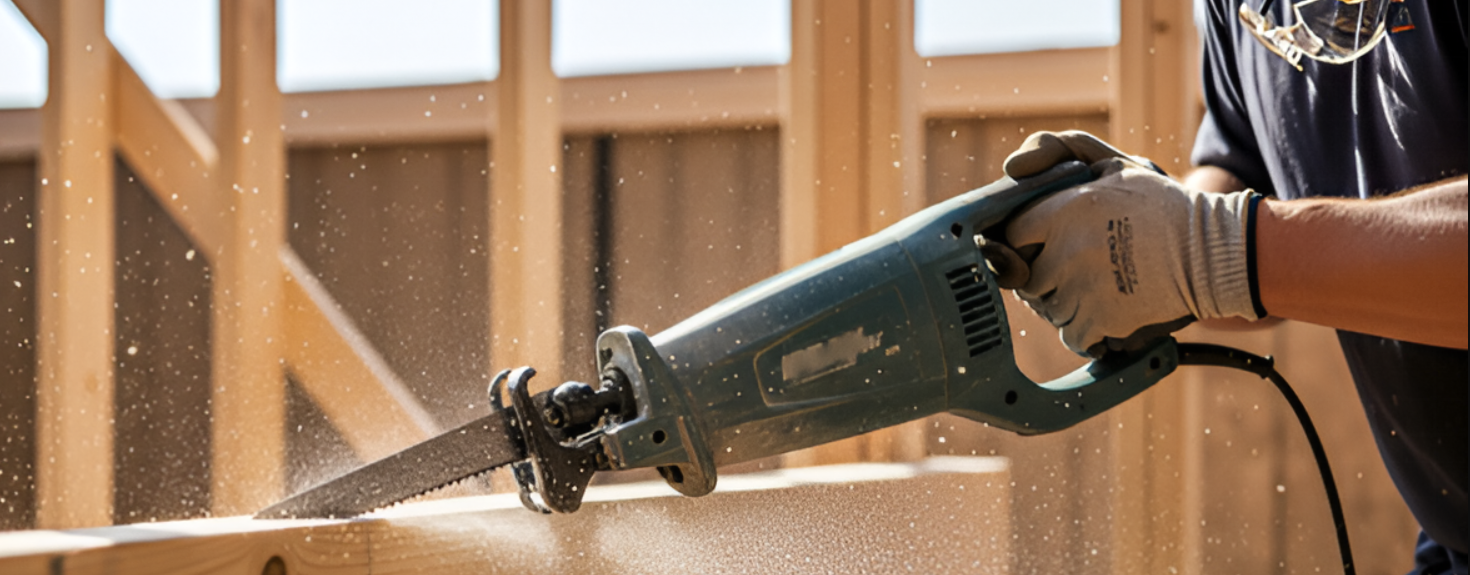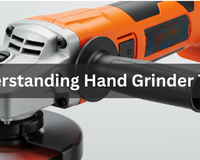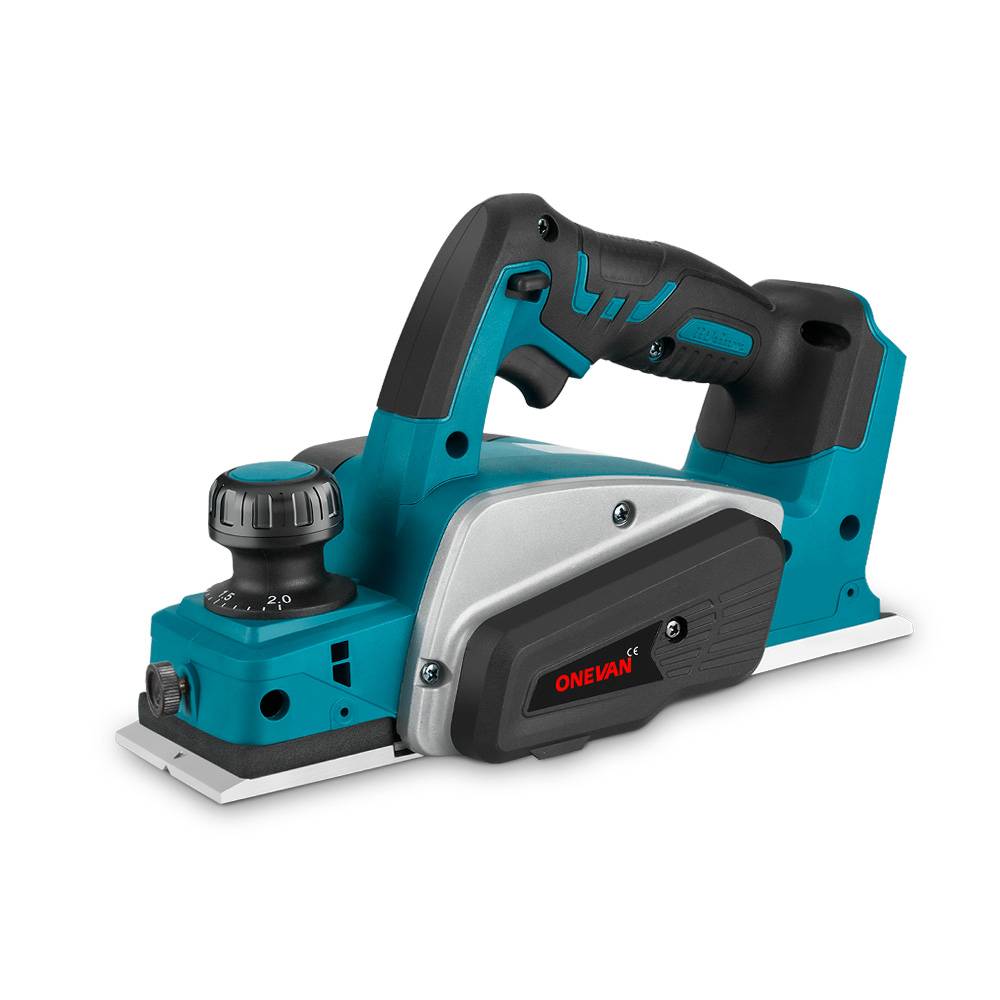"Power tools are amazing because they take raw wood and materials and turn them into something functional and beautiful.” These are the words of Serena, an accomplished DIY enthusiast known for her innovative projects, who has received recognition for her contributions to the DIY community. And you know what, her number one power-cutting tool is a reciprocating saw. You can see many other DIYers and homeowners praising this amazing tool as well.
If you are the one who wants to turn their home into a piece of DIY art or a professional who want to grab the attention in the market, reciprocating saw is your number one go-to tool However, don’t be intimidated by its use; this guide will provide you with essential tips and techniques to help you use the reciprocating saw effectively. After reading this guide, you will be well aware of the nitty-gritty of this powerful cutting tool. So let’s dive in.
1. What is a Reciprocating Saw?
Understanding a Reciprocating Saw:
A reciprocating saw is a power cutting tool that operates using a back-and-forth motion, converting rotational energy from the motor into reciprocating movement. In this mechanism, the rotational energy of the motor is converted into reciprocation. The blade is secured in a fixed position during operation, but it moves back and forth to perform cutting actions, and its position can be adjusted for different cutting tasks. You can use this for cutting metals, wood, home renovation, and DIY materials as well.
2. Key Components of a Reciprocating Saw
Blade types
The main thing you should always keep in mind is the use of the right blade. Every material type needs a different blade for accurate cutting. For different materials, specific blade types are needed; for example, metals require specialized blades, while wood and masonry also need their own specific blades. So, make sure to have proper knowledge about this thing before using a reciprocating saw.
Variable speed settings
The speed of a reciprocating saw is usually measured in strokes per minute (SPM), which indicates how many times the blade moves back and forth in one minute. The range completely depends on the type of material you are cutting. The speed of reciprocating saws can vary widely depending on the model, with many capable of reaching speeds around 2800-3200 SPM, though some may offer higher or lower rates.
Tool-free blade change mechanism
This is the easiest way to replace the blade of a reciprocating saw. You won't need a screwdriver for blade changes with a tool-free mechanism, simplifying the process and reducing hassle. There's a lever or button on the reciprocating saw that you press to remove the old blade. With just a little effort, you can then put on the new blade. That’s so simple.
3. Types of Reciprocating Saws
Corded Reciprocating Saws:
A corded reciprocating saw requires a continuous power supply with a cord connected to it. Corded reciprocating saws are often more economical for prolonged use. You can work with it for long hours without worrying about battery usage, as its working principle is different. However, one drawback is that it cannot be carried out for large projects or in tight spaces during home renovation.
Cordless Reciprocating Saws:
A cordless reciprocating saw is pretty reliable and easy to use when you need a lot of mobility. Because it operates on a battery system, you can easily transport a cordless reciprocating saw to your workplace without the constraints of a power cord. But as you know, you have to pay extra for extra comfort, so the cordless reciprocating saw is more expensive than others. But with ONEVAN, you can get your hands on the real reciprocating saw.
Compact Reciprocating Saws
This is the smallest and easiest to handle type of reciprocating saw. It can easily reach tight places. Typically, compact reciprocating saws are designed for single-handed use, are often cordless, and are well-suited for medium-duty tasks.
Full-sized models Reciprocating Saws
This type of reciprocating saw can handle heavier cutting tasks very easily. Due to its high speed and durability, it can handle most challenging cutting tasks more effectively.
4. How to Choose the Right Reciprocating Saw
1. Power Source
In order to choose the right reciprocating saw, the first thing to consider is the power source. In the market, both corded and cordless reciprocating saws are available. It depends on your convenience and usability to select one. A corded reciprocating saw is particularly useful when you need to work for extended periods without power interruptions. And if you have to work on projects at far-off places where a continuous power supply is not possible, you can use a cordless reciprocating saw.
2. Power and Speed
For a corded reciprocating saw, the power is measured in amps, while the power in a cordless reciprocating saw is measured in volts. Typically, a 10-12 Amp power supply is good for a corded reciprocating saw. An 18-21-volt battery is ideal for a cordless recip saw.
3. Stroke Length and Stroke Speed
Stroke length is the distance the blade covers in one pass. It affects the cutting speed and capacity of there reciprocating saw. Most reciprocating saws have a stroke length of around 1 to 1.5 inches, which is important for determining cutting speed and capacity. The stroke speed for reciprocating saws can vary, but higher-end models may reach speeds exceeding 3000 SPM, which can enhance cutting quality.
4. Ergonomics and Weight
The lightweight reciprocating saw is easy to carry for longer projects. As a DIYer, a lightweight reciprocating saw will make your life easier. In addition to weight, many recip saws are designed with ergonomic features that facilitate a good grip and enhance work efficiency.
5. Blade Change Mechanism
Usually, the tool-free blade change mechanism is considered best, while the right sawzall is preferred. With this mechanism, simply press the lever or button to remove the old blade and insert the new one.
7. Durability and Build Quality
Durability and build quality depend on various factors, including the materials used, the type of power source, resistance to corrosion, blade clamp strength, and the manufacturer's reputation.
8. Additional Features
LED Light:
Recip saw has LED lights installed in them that help to brighten up while working in dark spaces. This amazing feature is a cherry on top for professionals.
Adjustable Shoe:
The most amazing feature of a reciprocating saw is its adjustability. You can easily adjust it by moving in and out, and hence, the blade position can also be changed depending on the cutting material. It exposes different areas of the blade for specific cuts.
9. Budget and Brand Reputation
Choosing the right reciprocating saw depends on several factors, including your budget, the specific features you need, and the reputation of the brand. But if you want the longevity of your reciprocating saw, investing in a good brand is a wise decision. ONEVAN’s cordless reciprocating saw is one of the most trusted saws on the globe, so you can trust it.
5. Common Applications When Using a Reciprocating Saw
1. Demolition Work
Reciprocating saws are highly effective for many demolition projects, particularly for rough cuts and quick material removal. You can effectively use it to cut wood and metals, and with the right blade, it can also handle masonry tasks. Its fast-moving blade reliability will make your life easier while dealing with stubborn old materials.
Use Case:
- During renovation, you can knock down old walls.
- Nails and rods can be easily cut down with it.
- Broken frames of windows can be cut down without affecting the surrounding structures.
2. Plumbing
As a professional plumber or a simple homeowner who needs some plumbing work done at home, you can use a reciprocating saw. It will allow you to get into awkward spaces where other cutting tools are difficult to fit in.
Use Case:
- Use it to remove rusted iron while upgrading your bathroom.
- Cut down old PVC lines to install the new system.
- Trim the copper wire to facilitate the installation of the water heater replacement.
3. Electrical Work
Most electricians use a reciprocating saw for cutting various wiring materials. Due to its adjustable blade, a reciprocating saw can easily reach the congested areas of walls.
Use Case:
- To clear out the wall area for wire installation
- To shorten the EMT conduit for commercial wiring.
- To remove metal substances during the installation of new wiring,
4. Landscaping
As a gardener, you may encounter unusual tree branches that are costing the beauty of your lawn. In this scenario, a reciprocating saw will be your best friend.
Use Case:
- Cut out the old tree branches
- Remove the unusual roots that are hindering the garden
- Easily cut out the metal beams for fence creation
5. Metalwork
A reciprocating saw is one of the best tools for metal cutting. You just have to adjust the speed and use the right blade for cutting. Nowadays, so many DIYers and professionals are using this reciprocating saw for their metal work.
Use Case:
- In railing projects, you can easily cut aluminum substances.
- In machinery, you can easily cut out the bends of steel
- You can easily slice the rebar while working on the construction sites.
6. Home Renovation and DIY Projects
As we know, DIYers can’t compromise the beauty of their crafts, so this reciprocating saw is a special gift for them. With its use, they will no longer limit their crafts just because they can’t cut it down. Moreover, if you’re working on your home renovation, a reciprocating saw is your go-to tool.
Use Case:
- You can cut out drywall panels for new shelves.
- You can cut the pipes or rusted iron parts in your bathrooms.
- You can easily cut down the materials in congested areas.
7. Construction
Most of the constructors use a reciprocating saw to deal with different elements like nails, screw, etc that need fast cutting.
Use Case:
- It is used to cut wood lumber, plywood, and framing.
- For metal pipes, sheet metals, and pipe.
- You can cut concrete, brick, and pipes.
6. Preparation Before Use a Reciprocating Saw:
Before using the reciprocating saw, gather all necessary equipment, including the appropriate blade for your specific cuts, the right type of reciprocating saw for your project, and essential safety gear to ensure your safety throughout the process. After gathering equipment, you have to set up the workspace. Remove all the unnecessary equipment dust from the working site.If there are dust particles or unusual objects, they may hinder your work efficiency.
7. Step-by-Step Guide to Operating a Reciprocating Saw:
Step 1: Selecting the Right Reciprocating Saw Blade:
Blade selection is one of the most important steps. For different types of materials, you need a specific blade type. If you have to cut metal, you need a metal blade; for wood cutting, you have to use a wood blade, and the same is the case with other materials. This selection will depend on the efficiency of your work.
Step 2: Adjusting the Reciprocating Saw:
After blade selection, unplug the cord or remove the battery to install the blade. Press the lever to remove the old blade and then add the new one. Now, adjust the shoe for the specific cut with the blade. Make sure to keep the blade straight before tightening. Now test the blade by turning on the power supply.
Step 3: Positioning the Reciprocating Saw:
Now, grab the reciprocating saw firmly. Use both of your hands for proper positioning and good cuts. Place your dominant hand at the handle and your non-dominant hand behind the chuck of the reciprocating saw. By using both hands, you can position it in the right way.
Step 4: Making Cuts:
Straight cuts
These are the most common types of cuts. When you need to make precise cuts in a straight line, such as in building materials or pipes, you need to use them. But for these cuts, you need to firmly hold the reciprocating saw to avoid irregularity in the lines.
Curved cuts
Primarily used for cuts with rounded or irregular shapes. These cuts are mostly used for plywood when you have to make something custom.
Demolition cuts
Demolition cuts often prioritize speed for quick material removal, but maintaining a level of accuracy is still important for safety and effective results. When demolishing a building or an old raw material, you need to use a demolition blade, and then you're good to go.
Step 5: Finishing the Cut:
After doing your desired cuts, now press the button on the cordless reciprocating saw to remove the battery. And in case of a corded reciprocating saw, unplug the power supply. Remove the blade and keep it straight to prevent bending.
8. Common Mistakes When Using a Reciprocating Saw
1. Incorrect Blade Selection
Mistake: Using the wrong blade, such as high TPI for wood or low TPI for metal, will lead to inappropriate cuts.
Solution: Use a specific blade for each material type, such as a low TPI wood blade for wood and a high TPI sharp tooth blade for metals.
2. Neglecting Safety Gear
Mistake: Neglecting safety gear such as gloves, goggles, and hearing protection can expose you to potential hazards, including debris, metal dust, and noise-related injuries.
Solution: Always use safety equipment before cutting with a reciprocating saw.
3. Improper Handling and Control
Mistake: If you loosely hold the reciprocating saw or the position of the reciprocating saw is not proper, it will lead to improper cuts.
Solution: Always set the reciprocating saw at the proper position before using it. Hold it with both hands for precise cuts.
4. Skipping Pre-Cut Checks
Mistake: Always conduct thorough checks of the reciprocating saw, including blade sharpness, power supply, and the security of your workpiece, before making any cuts.
Solution: Always check your reciprocating saw before making cuts. Pre-cut checks will help you maintain the quality of cuts.
5. Forgetting to Secure the Workpiece
Mistake: If you don't secure the reciprocating saw in a fixed position, it can lead to an accident.
Solution: Don’t start your work without securing our workspace.
6. Ignoring Blade Maintenance
Mistake: If the blade isn’t sharp enough for cuts and you use it, this may lead to irregular cuts with a messy surface.
Solution: Regularly inspect the blade for sharpness, as a sharp blade is essential for efficient metal cutting and reduces the risk of damage to the material.
7. Improper Blade Installation
Mistake: Use of a sharp blade for wood and a less sharp blade for metals isn't a genius thing to do. This will not only damage your product but also incur significant time and financial losses.
Solution: Always gather proper knowledge about the perfect blade type for a particular product type.
8. Pushing the Saw Too Hard
Mistake: If someone applies excessive force to the motor, it will strain the motor and create uneven cuts.
Solution: You must let the blade do its function. Just slightly move the reciprocating saw, and you will get your desired cuts.
9. Conclusion
A reciprocating saw is one of the most used cutting tools in the market. Homeowners and professionals can use it easily for their home renovations or upgraded cutting projects. There are different types of reciprocating saws for different types of tasks. By understanding your specific cutting requirements and selecting the appropriate reciprocating saw and blade, you can make the cutting process more efficient and manageable.
While using the reciprocating saw, every user must wear the safety equipment and follow the guidelines given by the company. For efficient cutting tasks, you must choose the ONEVAN cordless reciprocating saw. They are famous for their reliable and easy-to-handle reciprocating saws.
10. FAQs
Can you use a reciprocating saw to cut trees?
Yes, a reciprocating saw is one of the best tools for cutting tree branches. But keep in mind to use a specific blade for wood.
Can I use a reciprocating saw to cut metal?
Yeah, with the metal blade and with the right approach, you can easily cut metal with a reciprocating saw.
Can you use a reciprocating saw as a jigsaw?
Yes, it can work, but with limitations. If you're working on extremely fine cuts, a reciprocating saw will not be able to do the right job. In this case, you should use a jigsaw.
Can you use a reciprocating saw to cut drywall?
You can use a reciprocating saw to cut drywall very quickly, especially when you have to make large openings. Use a demolition blade for this purpose.
Can you use a reciprocating saw to cut PVC pipe?
Yes, a reciprocating saw is excellent for PVC pipes. Use a fine-tooth blade for this purpose.
Can you use a reciprocating saw to trim hedges?
No, it's not recommended to trim hinges with it. It can cut branches easily, but for bulky hinges, a reciprocating saw is not a good option.
How to use a reciprocating saw for pruning?
You just have to use a pruning cutting blade, and the rest of the procedure is the same as used in other cuttings.
Can I use a reciprocating saw to cut concrete?
You can cut concrete with the reciprocating saw, but with the carbide grit blade. For thick structures, an angle grinder is more feasible than a reciprocating saw.









